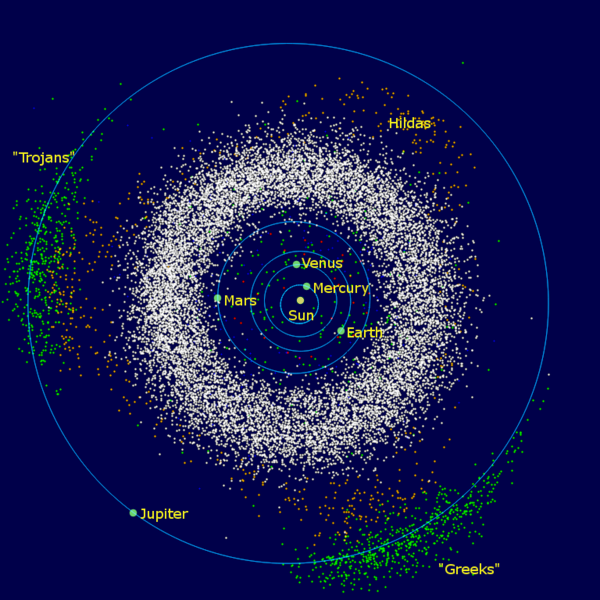How big would Nibiru's orbit be?
Its orbit takes 3600 years and is an ellipse with the sun as one of its two foci. [Kepler's First Law: "The orbit of every planet is an ellipse with the Sun at one of the two foci."]Kepler's third law states that
"The square of the orbital period of a planet is directly proportional to the cube of the semi-major axis of its orbit."The semi-major axis is the maximum distance of the orbit from its centre.
Let P be the orbital period of Nibiru (in sidereal years) and a be the semi-major axis of its orbit (in AU). Then
P 2 α a3Since the constant is 1 for the units given, that is, (sidereal year)2(AU)−3,
P 2 = a3and thus
a is the cube root of 3600 2Since Niribu is supposed to come close to Earth or even hit it, we assume that this is the closest Nibiru gets to the sun, one of its foci. This closest point is called the perihelion. So if 1 AU is the perihelion, what is the distance to the aphelion, the furthest point from the sun?
From the diagram, we see that it is simply twice the semi-major axis minus 1 AU. That is, the cube root of 36002 minus 1 which is 469 AU to the nearest AU. The diagram below shows the comparative maximum distances in AU from the sun
| Max distance from the sun in AU |
and the table gives the figure for each of the planets.
| Planet | Orbital Period years | Max Distance from Sun AU | Min Distance from Sun AU | Average Orbital Speed km/s |
|---|---|---|---|---|
| Mercury | 0.24 | 0.47 | 0.31 | 47.87 |
| Venus | 0.62 | 0.73 | 0.72 | 35.02 |
| Earth | 1 | 1.02 | 0.98 | 29.78 |
| Mars | 1.88 | 1.67 | 1.38 | 24.08 |
| Jupiter | 11.86 | 5.49 | 4.95 | 13.07 |
| Saturn | 29.46 | 10.12 | 9.05 | 9.69 |
| Uranus | 84.32 | 20.08 | 18.38 | 6.81 |
| Neptune | 163.79 | 30.44 | 29.77 | 5.43 |
| Pluto | 248.09 | 49.31 | 29.66 | 4.67 |
| Nibiru | 3600 | 469 | 1 | ??? |
What would its orbit look like?
Using Dr. Douglas P. Hamilton's Orbital Calculator, the values semimajor axis 235 AU, eccentricity 0.995744 and eccentric anomaly 1.418 give the min and max values described above. [Source] This gives a semiminor axis of about 20 AU. Eccentricity is a measure of how far from a circle an ellipse is and ranges from 0 (for a circle) to 1. The orbit is cigar shaped.How fast is it going?
Nibiru's orbit sends it 469 AU from the Sun. The gravity from the Sun on Nibiru at such a distance, if it has about the same mass as the Earth, would be around 1/4 millionth that of the Sun on the Earth. Since the gravity is so little, Nibiru will have almost escaped from the Sun's gravity. In order to do this, when it is close in to the Sun, it must almost reach the Sun's escape velocity. The Sun's escape velocity at Earth's orbit is about 42 km/s. That means Nibiru would be travelling at somewhere between the speed of Mercury and Venus. If my calculations are anything like correct, it would seem to only be going at about 0.09 km/s when it's at its aphelion. [Using Kepler's Second Law:"A line joining a planet and the Sun sweeps out equal areas during equal intervals of time."]It seems I'm doing something wrong since apparently, Nibiru's orbital velocity is
3.8 x 108 Kilometres per year (or roughly 2.5 AU a year). [Source]So, for Nibiru to be here on 21st December 2012, it would have to be around 4.2 AU from Earth now. That is around Jupiter's orbit. Surely it would be visible either through infrared or visible light or by gravitational effects?
From this source, Nibiru would be around 7.2 AU from the Sun now, and of magnitude 4.8, if it were the size of Earth.
How will other planets and objects affect its orbit?
Such an elongated orbit is highly unstable (why? I don't know) and so any interaction with a planet or anything else could easily knock it off its orbit.http://www.2012hoax.org/nibiru
http://www.sjsu.edu/faculty/watkins/orbital.htm
http://astroblogger.blogspot.com/2011/04/looking-for-nibiru.html
http://www.astrosociety.org/2012/ab2009-32.pdf
circumference of an ellipse calculator


